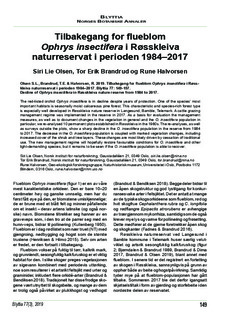Tilbakegang for flueblom Ophrys insectifera i Røsskleiva naturreservat i perioden 1984–2017
Peer reviewed, Journal article
Published version

Åpne
Permanent lenke
http://hdl.handle.net/11250/2621319Utgivelsesdato
2019Metadata
Vis full innførselSamlinger
- Scientific publications [1392]
Sammendrag
The red-listed orchid Ophrys insectifera is in decline despite years of protection. One of the species’ most important habitats is seasonally moist calcareous pine forest. This characteristic and species-rich forest type is especially well developed in Røsskleiva nature reserve in Langesund, Bamble, Telemark. A cattle grazing management regime was implemented in the reserve in 2017. As a basis for evaluation the management measures, as well as to document changes in the vegetation in general and the O. insectifera population in particular, we re-analysed 10 permanent plots established in Røsskleiva in the 1980s. The re-analyses, as well as surveys outside the plots, show a sharp decline in the O. insectifera population in the reserve from 1984 to 2017. The decrease in the O. insectifera population is coupled with marked vegetation changes, including increased cover of the shrub and tree layers. These changes are most likely driven by cessation of traditional use. The new management regime will hopefully restore favourable conditions for O. insectifera and other light-demanding species, but it remains to be seen if the O. insectifera population is able to recover.